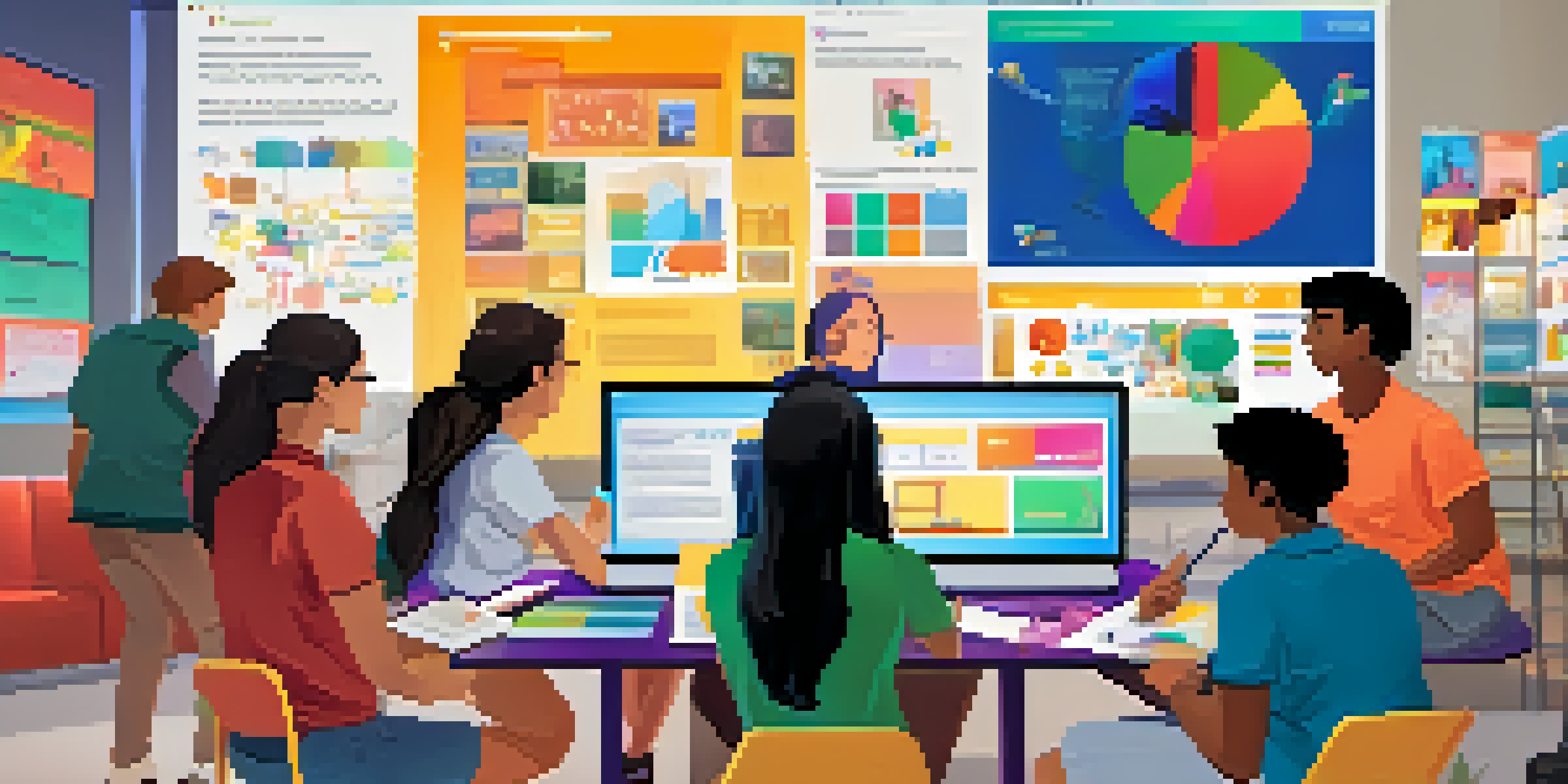Transmedia Learning: Strategies for Effective Online Collaboration

Understanding Transmedia Learning in Online Environments
Transmedia learning refers to a teaching approach that uses multiple media formats to enhance understanding and engagement. By incorporating various platforms, like videos, podcasts, and interactive apps, learners can access information in ways that suit their preferences. This approach not only caters to diverse learning styles but also makes the content more relatable and memorable.
The future of education is not just about technology, but how we use technology to transform learning experiences.
For instance, a history lesson might include a documentary, a blog post, and a virtual reality experience of a historical event. Such a rich mix allows learners to explore the subject from different angles, deepening their comprehension. This multifaceted strategy is particularly effective in online collaborative settings, where students may be spread across various locations.
In essence, transmedia learning transforms the traditional learning experience into an interactive journey. It encourages learners to engage actively with content, fostering a sense of community and collaboration. As we delve into effective strategies for online collaboration, understanding this foundation is crucial.
Cultivating a Collaborative Online Learning Environment
Creating a collaborative online learning environment starts with establishing trust among participants. When learners feel safe to express their ideas and opinions, collaboration flourishes. Building this trust can be achieved by encouraging open communication and setting clear expectations for group interactions.

Utilizing technology tools like discussion forums, video conferencing, and collaborative documents can also enhance interaction. For example, platforms such as Google Docs allow multiple users to edit and comment on a project in real time, fostering a sense of teamwork. These tools not only make collaboration easier but also help maintain organization and transparency.
Transmedia Learning Enhances Engagement
Utilizing various media formats, such as videos and podcasts, fosters deeper understanding and retention among learners.
Ultimately, a collaborative environment thrives on mutual respect and shared goals. By promoting a culture of collaboration, educators can empower learners to contribute actively and learn from each other, making the online experience richer and more fulfilling.
Leveraging Diverse Media for Engaging Content
In transmedia learning, the use of diverse media is crucial for maintaining engagement. By incorporating videos, podcasts, infographics, and interactive quizzes, educators can cater to different learning preferences. This variety not only keeps learners interested but also helps to reinforce the material through multiple channels.
Collaboration is the essence of life. The more you seek the growth of others, the more you develop your own.
For example, a science lesson could include a video demonstration of an experiment, supplemented by an infographic that summarizes key concepts. This combination allows learners to visualize the information while also having a quick reference. Such multimedia integration ensures that content is not only informative but also captivating.
As learners interact with different formats, they are more likely to retain information. This strategy of leveraging diverse media not only enhances engagement but also encourages a deeper understanding of the subject matter, making online collaboration more effective.
Establishing Clear Goals and Roles in Collaboration
Clear goals and defined roles are essential for effective online collaboration. When participants understand what is expected of them and the overall objectives of the project, it minimizes confusion and enhances productivity. Setting these parameters ensures that everyone is on the same page and working towards a common purpose.
For instance, in a group project, assigning specific roles such as researcher, writer, or presenter can help streamline efforts. Each member knows their responsibilities, allowing them to focus on their tasks while contributing to the group's success. This structure not only supports accountability but also fosters a sense of ownership among participants.
Collaboration Thrives on Clear Roles
Defining clear goals and roles in group projects minimizes confusion and boosts productivity among participants.
Ultimately, when learners are aligned in their goals and roles, collaboration becomes more seamless. This clarity empowers individuals to take initiative and work collectively, leading to more successful outcomes in their online learning experiences.
Fostering Communication and Feedback Among Learners
Effective communication is the backbone of successful online collaboration. Encouraging learners to share their thoughts, ideas, and feedback openly creates a dynamic learning environment. Regular check-ins and discussions can help maintain a flow of communication, ensuring that everyone feels included.
Feedback plays a vital role in enhancing learning outcomes. When learners receive constructive feedback on their contributions, it helps them refine their skills and understanding. Tools like peer reviews or group critiques can facilitate this process, allowing participants to learn from one another.
Incorporating structured communication and feedback mechanisms promotes a culture of continuous improvement. As learners feel supported in their interactions, they are more likely to engage deeply and collaboratively, enriching the online learning experience.
Utilizing Technology Tools for Seamless Collaboration
Technology plays a pivotal role in facilitating seamless online collaboration. There are numerous tools available that can enhance communication, organization, and project management among learners. Tools like Trello for task management or Slack for communication can streamline workflows and keep everyone informed.
Additionally, using platforms that allow for real-time collaboration, such as Miro or Microsoft Teams, can foster creativity and idea-sharing. These tools enable learners to brainstorm and develop projects collectively, regardless of their physical locations. The flexibility offered by technology creates opportunities for richer collaboration.
Feedback Fuels Continuous Improvement
Encouraging open communication and structured feedback enhances learning outcomes and promotes a culture of collaboration.
By leveraging the right technology tools, educators can enhance the collaborative experience significantly. This not only simplifies the process but also encourages innovation and teamwork, making online learning more interactive and engaging.
Assessing Collaborative Learning Outcomes Effectively
Assessing collaborative learning outcomes can be challenging but is essential for understanding the effectiveness of the process. It’s important to evaluate both individual contributions and group dynamics to gain a comprehensive view of the learning experience. This dual assessment approach ensures that all aspects of collaboration are considered.
Using rubrics that outline specific criteria for evaluation can help provide clarity in the assessment process. For example, criteria may include participation, communication, and the quality of work produced. This structured approach not only sets clear expectations but also provides constructive feedback to learners.

Ultimately, effective assessment of collaborative learning outcomes contributes to continuous improvement. By reflecting on both the successes and areas for growth, educators can refine their strategies, leading to more successful and enriching online collaboration in the future.